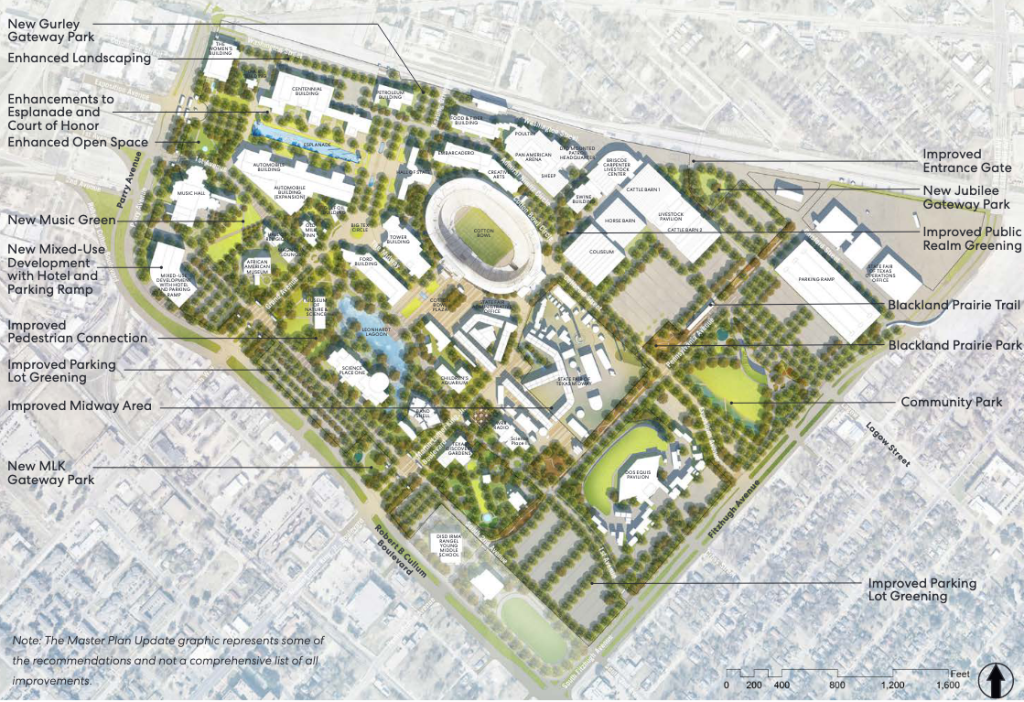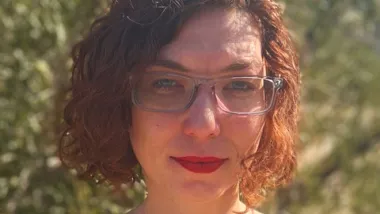A 20-year plan to revitalize a historic Dallas fairground will bring much-needed new green space and multi-use venues to Fair Park.

Built in 1886 to host the annual Texas State Fair, Fair Park has a long history as a vast and diverse public space and events venue. The site briefly served as a U.S. Army camp during World War I before becoming home to the Cotton Bowl stadium in 1926, hosting the eponymous annual college football game. It was also, for a time, home to the Dallas Cowboys professional football team.
Inspired by the City Beautiful Movement, the park’s first planner, George Kessler, designed a space featuring tree-lined boulevards, monumental public art, fountains, and other features meant to create a beautiful and calming public space. After hosting the 1937 World’s Fair, the park retained more than half of the World’s Fair structures, making it the largest collection of Art Deco architecture in the world. One hundred years after its construction, Fair Park was listed as a National Historic Landmark. Today, the park is home to several museums and institutions including an aquarium, music hall, the African American Museum of Dallas, and Dos Equis Pavilion.
Despite its colorful history, the space languished, underused, for decades. While an estimated five million people attend events at Fair Park every year—primarily for the annual Texas State Fair that takes place over three weeks in the fall—it remained underutilized, with much of the area fenced off and without amenities to make it a pleasant space for everyday recreation. Meanwhile, the city used eminent domain to acquire local properties from residents and build surface parking lots where homes once stood.
In 2019, the site came under the management of a public-private partnership, Fair Park First, that seeks to reactivate the site and build a new community park that will bring more events, amenities, and much-needed green space to the area. After a series of missteps by former operators, the new partnership hopes to regain the community’s trust and give back a valuable, welcoming public space and daily destination for surrounding neighborhoods.
Slated to open in 2024, the new master plan, developed by Biederman Redevelopment Ventures (BRV), boasts “a state-of-the-art Community Park with interconnected parklets and trails across the campus, all with regular programming.” Access to the park will be improved for pedestrians, cyclists, and drivers. The master plan envisions restoring and preserving the park’s historic structures, strengthening community inclusion, and attracting new tenants and events to the park’s facilities. The 11-acre Community Park site, which was selected after an extensive public engagement process, will replace an existing 14-acre surface parking lot. The park will be surrounded by a bike trail that will connect to regional trails and stormwater management facilities. While the park’s design has not been finalized, according to Fair Park First, “The community input for the Master Plan Update identified the desire for splash pads, multiple play structures for children of different ages and abilities, Wi-Fi, a performance pavilion, picnic shelters, game tables, food and beverage offerings, fitness trails, a dog park, and flex lawns.”

The park’s designer, Los Angeles-based Studio-MLA, has worked on projects that include Vista Hermosa Natural Park and the Los Angeles County Natural History Museum’s Nature Gardens. The project is privately funded and will remain open during events like the State Fair of Texas as a public park outside of event boundaries, according to Ashley Langworthy of BRV.
Boosters hope the new master plan will breathe life into the historic site and reweave the community together with new amenities in an accessible, welcoming, and vibrant space.

Planetizen Federal Action Tracker
A weekly monitor of how Trump’s orders and actions are impacting planners and planning in America.

Chicago’s Ghost Rails
Just beneath the surface of the modern city lie the remnants of its expansive early 20th-century streetcar system.

Amtrak Cutting Jobs, Funding to High-Speed Rail
The agency plans to cut 10 percent of its workforce and has confirmed it will not fund new high-speed rail projects.

Ohio Forces Data Centers to Prepay for Power
Utilities are calling on states to hold data center operators responsible for new energy demands to prevent leaving consumers on the hook for their bills.

MARTA CEO Steps Down Amid Citizenship Concerns
MARTA’s board announced Thursday that its chief, who is from Canada, is resigning due to questions about his immigration status.

Silicon Valley ‘Bike Superhighway’ Awarded $14M State Grant
A Caltrans grant brings the 10-mile Central Bikeway project connecting Santa Clara and East San Jose closer to fruition.
Urban Design for Planners 1: Software Tools
This six-course series explores essential urban design concepts using open source software and equips planners with the tools they need to participate fully in the urban design process.
Planning for Universal Design
Learn the tools for implementing Universal Design in planning regulations.
Caltrans
City of Fort Worth
Mpact (founded as Rail~Volution)
City of Camden Redevelopment Agency
City of Astoria
City of Portland
City of Laramie






























